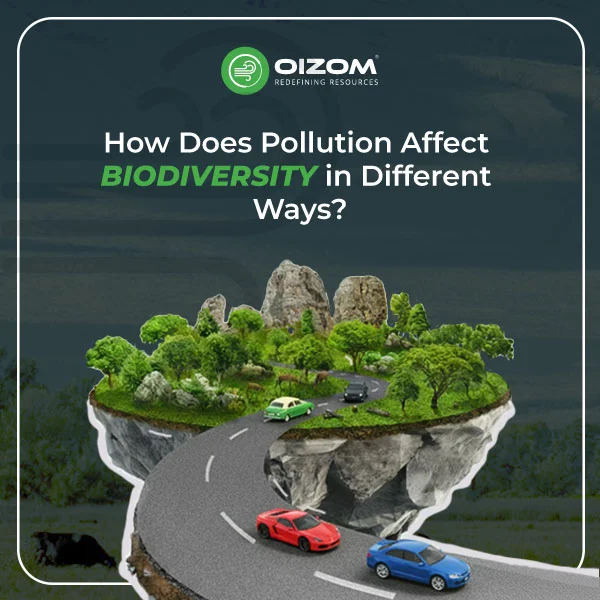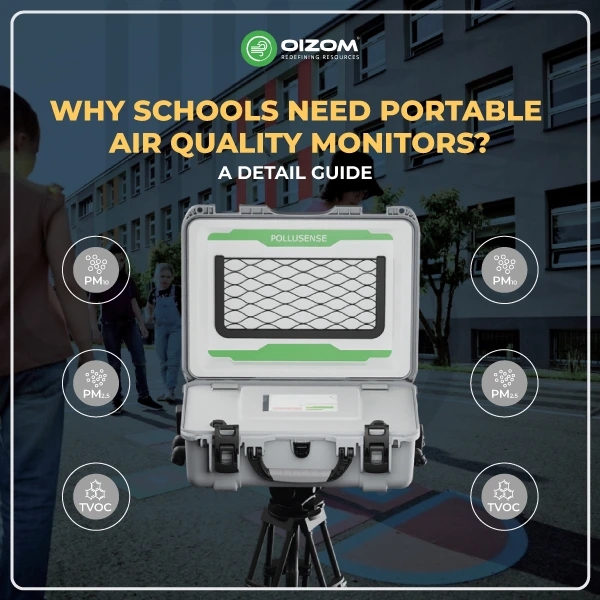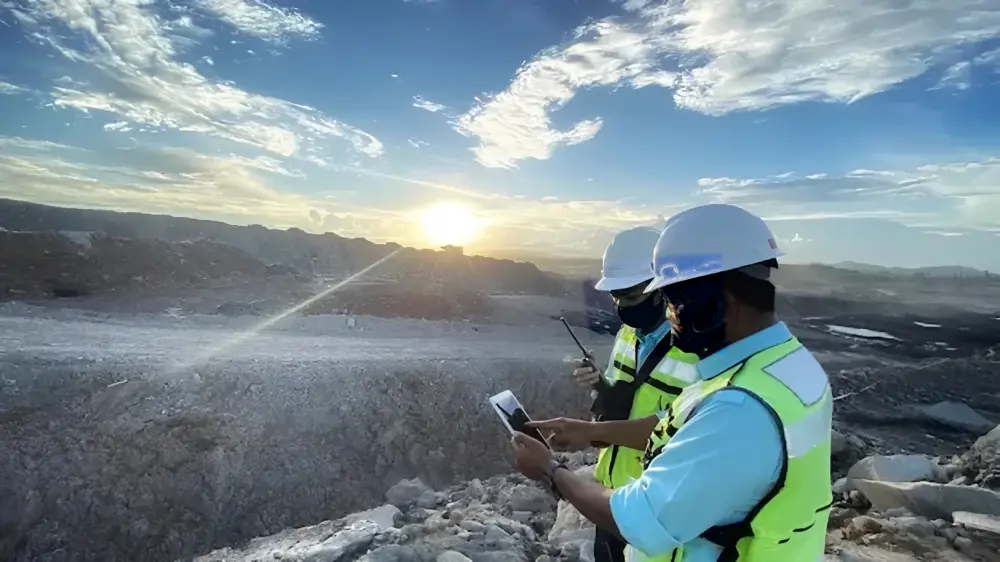Summary
Air pollution is quietly reshaping the natural world, affecting plants, animals, and entire ecosystems. Pollutants such as particulate matter, ozone, nitrogen oxides, sulfur dioxide, VOCs, and heavy metals reduce photosynthesis, damage leaf and pollen structures, disrupt reproductive cycles, and compromise animal health, initiating a chain reaction throughout food chains. Gradually, these changes endanger biodiversity and the ecosystem we rely on, from clean air and water to pollination and climate regulation.
Monitoring air quality is vital in detecting these threats early and taking proactive steps. Practical steps, such as planting trees, reducing fossil fuel use, implementing industrial emission controls, and adopting policy measures, can collectively help protect biodiversity. By understanding and acting upon the connections between air pollution and nature, we can maintain the fine balance of life while building a healthier environment for tomorrow.
Introduction
Air pollution is more than just smog over city skylines; it’s an invisible force gradually altering the natural world. Studies suggest that in some industrial regions, up to 20% of plant species exhibit restricted growth due to chronic exposure to pollutants. Evidencing itself as a significant threat to global ecosystems, air pollution primarily stems from unchecked industrialization, the expansion of urban landscapes, and congested transportation networks.
Both plants and animals, the backbone of our ecosystem, struggle with the Ripple effects of worsening air quality. Leaves are getting damaged, pollen weakened, and soil health compromised, creating ripple effects across entire food chains. From stunted vegetation to stressed wildlife, the impacts accumulate, endangering biodiversity and disrupting ecosystem balance.
A thorough understanding of these outcomes is necessary to acknowledge the silent stress on nature and to determine ways for mitigation and conservation. By observing and acting on these signs, we can begin to safeguard the intricate web of life that sustains our planet.
Why Air Pollution and Biodiversity Are Closely Linked?
Air pollution is not just something that makes the air difficult for people to breathe; it has a profound impact on the survival of plants, animals, and ecosystems. Biodiversity relies on intricate webs of connections, and when pollutants disrupt even one of these webs, the effects can alter landscapes and reduce species diversity.
Particulate Matter (PM2.5 and PM10):
Fine particles deposit as a layer on plant leaves, restricting light access and photosynthesis. With reduced energy production by up to 25%, the growth efficiency of plants in polluted areas is weakened, providing fewer resources to herbivores. This trickle-down cascades upwards, constraining resources for upper trophic levels.
Ozone (O₃):
High concentrations of ozone harm leaf tissues and limit nutrient uptake. Cutting leaf area by 10–15% not only hinders plant vigor but also reduces the habitats of insects and animals that rely on them, constricting biodiversity at several levels.
Nitrogen Oxides (NOx) and Sulfur Dioxide (SO₂):
They acidify waters and soils upon emission, thereby destabilizing nutrient cycles. Acidification reduces microbial diversity by about 20–30%, thereby hindering the decomposition and recycling of nutrients. As soil health worsens, so does the basis of ecosystems, from fungi to forests.
Volatile Organic Compounds (VOCs) and Heavy Metals:
These pollutants accumulate in living organisms, inducing toxic stress. From plant reproduction impairment to reduced hatching success in birds, the toxic accumulation erodes species’ survival and resilience, and consequently, diversity over time.
The link is obvious when pollution influences growth, reproduction, or survival at any point in the food web; it remakes biodiversity itself. Air quality, then, is not simply an environmental issue, but a direct factor in how rich, robust, and balanced our ecosystems remain. Defending clean air is equivalent to protecting the diverse life that sustains life on the planet.
How Does Pollution Affect Biodiversity in Different Ways?
Air pollution interferes with biodiversity at various levels, weakening vegetation by inhibiting photosynthesis, damaging leaf morphology, lowering reproductive vigor, and also impairing animals with respiratory complications, neurological dysfunction, hormonal disruption, and disease susceptibility. Collectively, these effects radiate throughout ecosystems, endangering the equilibrium of food webs and the existence of untold species.
Effect of Air Pollution on Plants
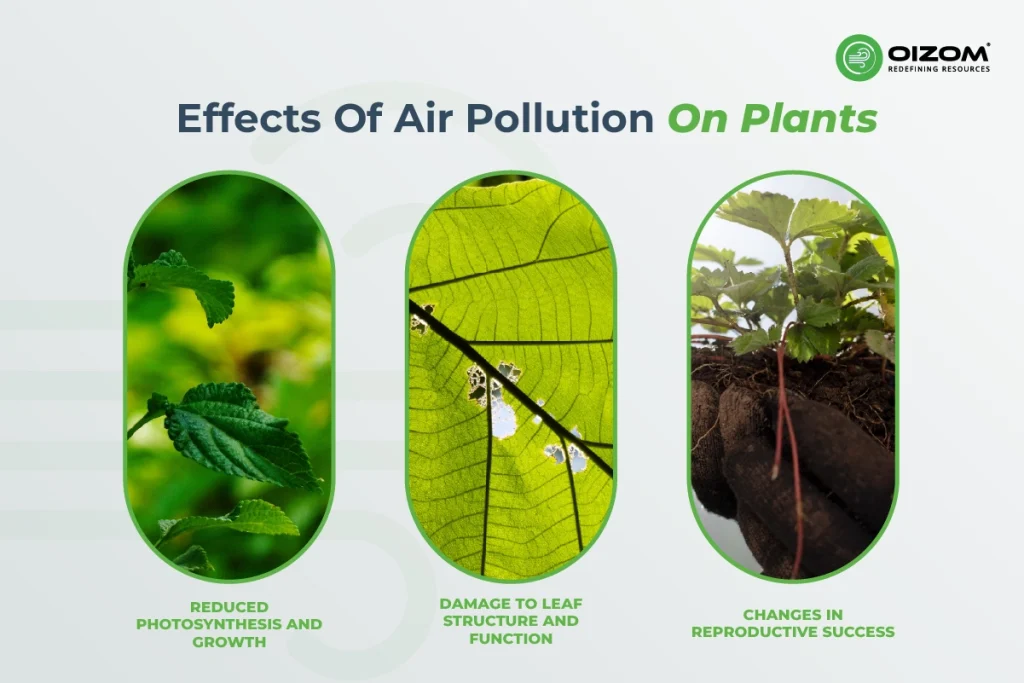
Reduced Photosynthesis and Growth
Photosynthesis, the cornerstone of plant life, ensures growth and nourishment. This process is imperiled by particulate matter, ozone, sulfur dioxide, and nitrogen oxides, which often hinder chlorophyll’s absorption, derailing the conversion of light into chemical energy. Studies show that a 10% reduction in photosynthesis can lead to a 5–8% decline in crop yield, with nutrient-rich crops, such as soybeans, being significantly affected even in mildly polluted environments.
Damage to Leaf Structure and Function
Air pollutants settle on leaf surfaces, causing visible symptoms like necrotic spots, yellowing, stippling, and premature leaf drop. These damages disrupt transpiration, making plants vulnerable to heat stress, nutrient deficiencies, and disease.
Changes in Reproductive Success
Pollutants can damage pollen, compromising plant reproduction. This leads to a cascading effect: herbivores face food shortages, which in turn impact predators that depend on them.
Examples in the US: Black Cherry shows extensive foliar injury in ozone-heavy areas, while Eastern White Pine needles display discoloration and damage from sulphur dioxide exposure.
Effect of Air Pollution on Animals
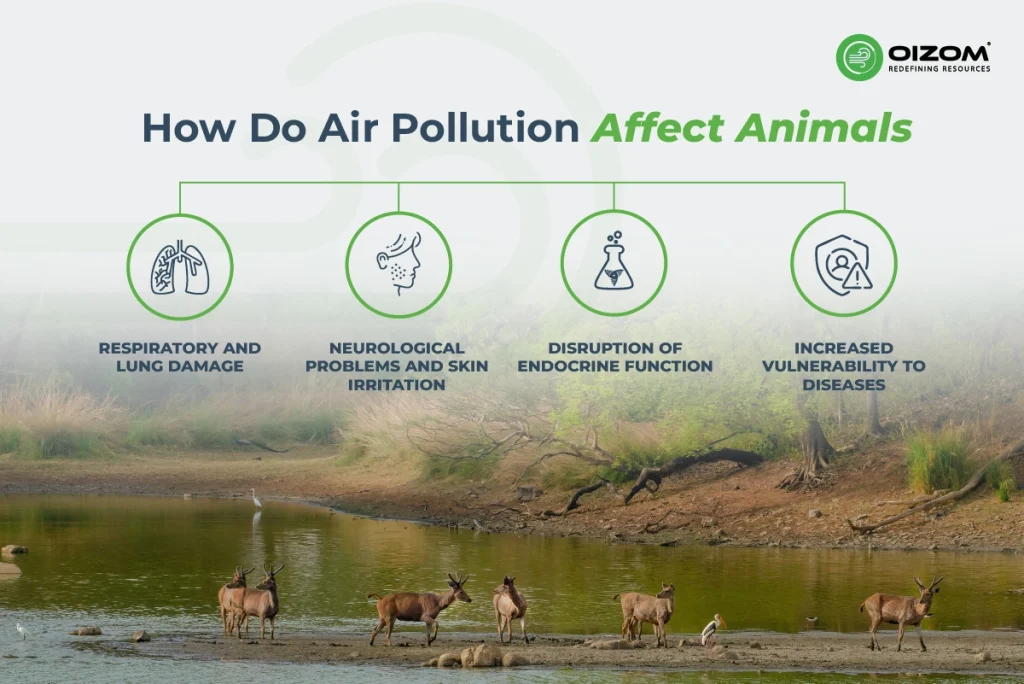
Respiratory Issues and Lung Damage
Like humans, animals suffer from bronchitis, asthma, and irreversible lung damage. Urban pigeons and semi-urban deer are particularly affected.
Neurological Problems and Skin Irritation
Some pollutants are neurotoxic; urban birds have altered songs, which affects mating, while particulate matter triggers skin irritations, reducing overall fitness.
Disruption of Endocrine Function
Endocrine-disrupting chemicals cause hormonal imbalances, which can impact reproduction and survival. Amphibians show skewed sex ratios and limb deformities.
Increased Vulnerability to Diseases
Pollutants weaken an animal’s immunity, making them more susceptible to diseases. Amphibians in the US, for example, have faced sharp population declines due to fungal infections.
Examples in the US include urban birds, such as sparrows and kestrels, which exhibit diminished hatch rates. Aquatic ecosystems, such as the Chesapeake Bay, experience algal blooms resulting from nitrogen oxide emissions, which deplete oxygen and endanger fish populations.
Pollution and Biodiversity Loss: The Bigger Picture
The effect of air pollution on biodiversity goes far beyond isolated plants and animal species; it restructures entire ecosystems and, ultimately, the services they offer to people. Across the globe, degraded habitats are experiencing measurable declines in species richness and abundance. For example, research indicates that as many as 20% of forest plant species in industrial areas experience reduced growth or reproductive ability due to chronic exposure to nitrogen and sulfur chemicals. Similarly, urban and peri-urban wildlife communities, including birds and small mammals, have been reduced by 10–15% over the last two decades in highly polluted areas.
When combined, ozone, particulate matter, and heavy metals can disrupt food chains, lower soil fertility, and disturb both aquatic and terrestrial ecosystems. These impacts can have chain effects, such as reduced green areas, which reduces habitat and food for herbivores, fewer herbivores affect predators, and the overall stability of ecosystems decreases.
From a human point of view, lost biodiversity means less resilient ecosystem services, worsened air quality, pollination disruption, reduced water cleansing, and less natural protection against climate extremes. Simply put, air pollution not only harms wildlife but also erodes the natural foundation that supports human societies. This demonstrates that fighting air pollution isn’t just about human health but a global priority for environmental balance and long-term well-being.
Why Monitoring Air Quality Is Crucial for Protecting Nature?
Air quality monitoring isn’t just about human health; it’s a critical tool for protecting plants, animals, and entire ecosystems. By tracking specific pollutants, we can detect early warning signs of environmental stress and take timely action.
- Particulate Matter (PM2.5 and PM10): These tiny particles settle on leaves, reducing photosynthesis and stunting plant growth. Monitoring their levels helps predict when vegetation is at risk and can guide measures to minimize exposure to these toxins.
- Ozone (O₃): High ozone concentrations damage leaf tissues and impair plant respiration. Real-time monitoring allows authorities to anticipate periods of heightened stress for sensitive species and implement mitigation strategies.
- Nitrogen Oxides (NOx) and Sulfur Dioxide (SO₂): These gases acidify soils and water bodies, affecting nutrient cycles and soil microbes. Tracking NOx and SO₂ levels can inform interventions aimed at preventing long-term biodiversity loss.
- Volatile Organic Compounds (VOCs) and Heavy Metals: These pollutants accumulate in plants and animals, causing reproductive and developmental issues. Monitoring helps identify contamination hotspots and prioritize conservation efforts.
By keeping a close watch on these pollutants, scientists and policymakers can not only protect individual species but also preserve the complex interactions within ecosystems. In essence, air quality monitoring acts as a nature’s health dashboard, showing us where interventions are needed to maintain the delicate balance of life.
Practical Steps to Reduce Air Pollution and Protect Biodiversity
Protecting biodiversity starts with reducing air pollution at every level: individual, community, and industrial. Here are practical steps that are easy to understand and implement:
1. Promote Green Spaces:
Planting trees and maintaining urban green spaces helps absorb pollutants such as NOx, SO₂, and particulate matter. Even small green patches in cities can improve air quality and provide habitats for birds and insects.
2. Reduce Fossil Fuel Use:
Switching to cleaner energy sources, utilizing public transportation, and promoting the use of electric vehicles can significantly reduce emissions of ozone precursors, NOx, and particulate matter. Less pollution means healthier plants and animals.
3. Industrial Emission Controls:
Industries should adopt technologies like scrubbers and filters to limit VOCs, SO₂, and NOx emissions. Regular monitoring ensures pollutants stay below thresholds that could harm ecosystems.
4. Sustainable Agriculture Practices:
Minimizing the use of chemical fertilizers and pesticides reduces the release of harmful nitrogen compounds into the air. This protects soil microbes, plants, and nearby aquatic life.
5. Community Awareness and Citizen Monitoring:
Encouraging citizens to track air quality using accessible apps or sensors empowers communities to advocate for cleaner air. Early warnings of high pollution can prevent stress on sensitive species and habitats.
6. Policy and Conservation Measures:
Support regulations that limit emissions and protect sensitive ecosystems. Policies such as emission caps, protected green corridors, and wetland preservation help maintain biodiversity in the long term.
By combining individual choices with industrial and policy-level actions, we can reduce air pollution while safeguarding the intricate web of life that sustains our planet.
Conclusion
The labyrinth of challenges posed by air pollution affects not just our health but the delicate balance of nature itself. Addressing it requires a multifaceted approach that combines community engagement, thoughtful policies, and innovative technologies, such as Oizom’s air quality solutions. By monitoring pollutants and taking timely action, we can protect both the species that share our planet and the ecosystems that sustain life.
While the journey toward cleaner air is challenging, every step counts. From planting trees and reducing emissions to supporting regulations that safeguard biodiversity, small and collective actions can make a profound difference.
FAQs
Sulfur dioxide (SO₂), nitrogen oxides (NOₓ), ground-level ozone (O₃), and particulate matter are the main culprits. These pollutants damage plants, acidify soil and water, and harm animal health. They originate mainly from vehicles, industries, and fossil fuel burning.
Yes, air pollution can degrade habitats and poison ecosystems. Acid rain and toxic gases harm sensitive species unable to adapt. This can lead to local or global species extinction over time.
Air pollution damages plant tissues and reduces photosynthesis. Animals suffer respiratory issues and weakened reproduction from polluted air. It also disrupts food chains by harming plants and insects.

